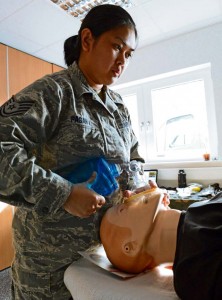Performing CPR on a patient who needs immediate medical attention sometimes isn’t enough. What are you to do if CPR isn’t working and the ambulance hasn’t arrived yet?
The 86th Medical Group offers an Advanced Cardiac Life Support course every two months to Airmen who are looking to sharpen their cardiac emergency care skills and learn what to do in those critical moments.

ACLS is a two-day course that teaches Airmen how to perform an advance level of care on a patient who has gone into cardiac arrest. ACLS is a multistep process done by the first responder and allows trained medics to extend the window of emergency care before the arrival of an ambulance. Those who are trained on an advanced level of cardiac arrest care do what doctors would be doing in the first hour of patient contact in the field.
“This training is proven to save lives,” said Master Sgt. Brian Donnelly, 86th Civil Engineer Squadron fire department district fire chief. “If I can perform advanced cardiac life support within the first six to eight minutes of patient contact, then I’ve got a 50/50 chance of a viable patient to have a positive outcome.”
The trainees practice on state of the art equipment called a patient simulator, a realistic, anatomically correct electronic mannequin that allows the trainee to exercise their skills on a more lifelike patient.
“The mannequins we had in the late ’70s and early ’80s are night and day compared to what we have now,” Donnelly said. “They hook up to the computers and these mannequins blink now, which is really awesome. So the realism is far and beyond anything I have ever been accustomed to in the early days of paramedicine.”
Learning how to handle and properly take care of a patient under these conditions isn’t the only thing these trainees deal with.
“The hands-on aspect of the training is really helpful, but the most helpful thing is the teamwork,” said Capt. Candice Milone, 86th Medical Operations Squadron clinical nurse. “When working with people in a real-world situation, you’re going to have to know how to communicate effectively.”
Donnelly said the real-world scenario is an experience like none other.
“That’s a relationship that I remember for the rest of my life. When you are there with the patient stopping excessive bleeding, reversing a chest pain or heart attack, and actually seeing the results of what you do with the tools and the things that you’ve learned, there’s nothing like it in the world,” he said.


